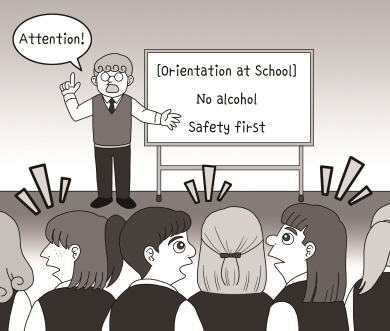
As one new model, a number of universities have organized their freshmen orientation on campus. Seoul National University held its event on campus in January, which was the first time the event took place on campus since 2012. Chung-Ang University also instructed its Student Government Association (SGA) to make the orientation a day’s trip on campus.
Moreover, Dongduk Women’s University cancelled its off-campus freshmen orientation which used to take place for two nights and three days after the Mauna Resort incident.
“Our university is now organizing programs and events for freshmen on campus,” said Hong Jong-myeong, an official of student administration office in Dongduk Women’s University. “After the official events provided by the university ends, SGA meets students with their own programs which are again to end in one day at school.”
Other universities which conducted orientations out of campus put safety measures as the foremost consideration in freshmen orientation this year. Universities took precautions to make sure no accident occurred during events and prepared manuals to deal with accidents that might take place. For one, Korea University conducted first aid and fire safety education to its SGA members before the orientation. Ewha Womans University made a safety check list for all colleges before students went off to freshmen orientations.
“Ewha’s freshmen orientations were always organized by both the university office and SGA so that safety issues regarding hotel was always ensured,” said Moon Ji-hae (French, 3), who guided the freshmen orientation this year. “What changed this year was the safety checklist which students in charge of the orientation checked thoroughly for every vehicle conveying students to the orientation site. Freshmen who participated in this year’s orientations seemed content overall.”
As an extension of ensuring safety during orientation, drinking habits were modified. Whereas drinking was considered a necessity in past freshmen events, university authorities are now pursuing ways to reduce the amount of drinking in this year's events. During Yonsei University’s orientations, under supervision of its SGA on its campus, there was no drinking in order to prevent any possible incidents. Sungkyunkwan University made its own drinking guideline to warn students of dangers of heavy drinking. Sookmyung Women’s University limited one can of beer per student during the orientation and students who participated in the orientation were required to hold a traveler’s insurance during the orientation days.
The Ministry of Education (MOE) and university authorities put great effort into organizing safe and sound orientations for students as the top priority of freshmen orientation this year was safety. On the other hand, some students miss the former ways of orientations where students were mainly in control of organizing the events. The MOE recommended universities to hold orientations under control of both university and its SGA, changing the atmosphere of what is used to be like when it was previously led only by students.
In February this year, SGA of Seoul National University, Yonsei University, Sungshin Women’s University and Kyonggi University wrote a resolution letter to ask the ministry's support of student-governed orientations, instead of advising students to follow the university in organizing such events.
Lee Ha-kyung
voteforkate@ewhain.net

